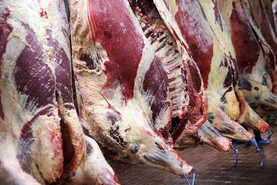It’s the question every suckler and beef farmer is asking – how long will the higher beef price hold? For ten years, the R3 price was 50 cent either side of €4/kg.
For the last three years the price has lifted to over €5/kg, and now this year the price will reach new heights, maybe even averaging over €7-€8/kg for the year. A clear signal of a real step change in beef output value.
Sheep farmers got that step change in lamb value a year earlier than suckler farmers. Again, they hovered around €5/kg for over ten years – got a step change to €7/kg in 2021, and then it pushed on even further.
In 2024, there was a year-on-year price increase of 15% to bring the price to over €8/kg in 2024, and it looks like it will exceed that again in 2025.
Back to the suckler farmer question – how long will this improved beef price continue? Based on their analysis of older stock numbers, Bord Bia has come out this week suggesting that finished cattle numbers will be back 70,000-90,000 heads this year on 2024 numbers.
In contrast, numbers show that cattle kill to-date is just over 25,000 heads ahead of the same time last year. It means farmers are killing earlier to try and take advantage of the higher price and in reality, it looks like it will lead to much tighter numbers in the second half of 2025.
Bord Bia predicted a 5% decline in supply of prime cattle year-on-year, so taking into account this latest information, this could indicate an 8% decline in supplies for the second half of the year.
All those lower number predictions from the start of the year were before we saw the 2025 spike in live exports.
Spain, Poland, Italy, the Netherlands and Northern Ireland have all jumped, with over 30,000 head extra gone to these countries already in 2025 compared to 2024.
Almost 200,000 heads left the country before the end of April and significantly, about 50,000 of that 200,000 are young cattle that now won’t be processed on the island later this year or next year.
Bluetongue
Obviously bluetongue is impacting on cattle and sheep numbers significantly in Europe and the UK. Reading reports on the decline in breeding stock in areas badly affected by bluetongue would suggest breeding numbers are back at least 10% and a lot more in some areas.
This will have a lasting impact on keeping stock numbers lower in the medium term.
Ireland continues to stay bluetongue free despite the disease prevalence in the southwest of England. As long as this continues, it will help drive the live export trade, which keeps an edge on numbers available to factories.
Remember that Bord Bia’s Donal Denvir was suggesting at the start of the year that UK beef production was forecast to fall 5% in 2025 and if anything, the bluetongue disease has further impacted these numbers.
Denvir also showed how the UK eating out market is booming relative to where it was two to three years ago.
In 2024, the UK represented 46% of total Irish beef exports – when the UK is going well and is short of beef, we are the number one preferred trading partner.
There was an effort to hold or even reduce beef price for the last two weeks, but again this looks like that was a futile exercise as quotes rebounded again this week.
So the short answer to the question is that all the market signals suggest beef price will hold, if not increase, as we move further into 2025.
Let’s not get carried away. Farmers deserve so much more. It’s all very fine talking about output values but up to now margins at farm level have not matched that output increase, because on-farm input costs sky rocketed over the same period from 2021.
Margins
It looks like 2025 margins will be better because costs are falling slightly and output values are holding or increasing.
More importantly, the weather that plays such an important part in farmer margins is working to their advantage again this year. Spring was good when it mattered and early summer so far has played ball.
Jason Loughrey from Teagasc suggests the average gross margin on single suckling farms increased to €582/ha in 2024, with a net margin of €78/ha.
This excludes EU support payments and a value on own labour. Similarly, on the average cattle finishing farm gross margin was €753/ha, with net margin estimated to be €131/ha in 2024. A more positive margin for suckler and sheep farmers in 2025 is long overdue.






 This is a subscriber-only article
This is a subscriber-only article










SHARING OPTIONS: